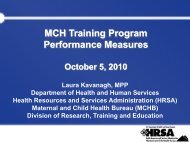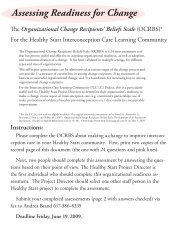Central Pennsylvania Womens Health Study (CePAWHS) - HRSA
Central Pennsylvania Womens Health Study (CePAWHS) - HRSA
Central Pennsylvania Womens Health Study (CePAWHS) - HRSA
You also want an ePaper? Increase the reach of your titles
YUMPU automatically turns print PDFs into web optimized ePapers that Google loves.
<strong>Central</strong> <strong>Pennsylvania</strong> Women’s<br />
<strong>Health</strong> <strong>Study</strong> (<strong>CePAWHS</strong>):<br />
Strong <strong>Health</strong>y Women<br />
Intervention<br />
Cynthia H. Chuang, MD, MSc<br />
Carol S. Weisman, PhD<br />
Marianne M. Hillemeier, PhD<br />
Sara A. Baker, MSW<br />
Penn State College of Medicine<br />
Hershey, PA<br />
November 18, 2010
Strong <strong>Health</strong>y Women is…<br />
An evidence-based behavioral<br />
intervention for improving the health of<br />
pre- and interconceptional women<br />
Designed to be administered in small<br />
groups with lay facilitators
What we will cover…<br />
Development of Strong <strong>Health</strong>y Women<br />
- Assessment of target population<br />
- Content and format issues<br />
Testing of Strong <strong>Health</strong>y Women<br />
- Evidence of effectiveness<br />
- Implementation issues<br />
Modifications to Strong <strong>Health</strong>y Women<br />
and next steps
The <strong>Central</strong> <strong>Pennsylvania</strong><br />
Women’s <strong>Health</strong> <strong>Study</strong> (<strong>CePAWHS</strong>)<br />
An ongoing program of research<br />
to improve women’s health<br />
and pregnancy outcomes,<br />
focusing on pre- and interconceptional women<br />
in low-income rural and urban communities
Research Objectives<br />
To identify the key risks for adverse<br />
pregnancy experiences and outcomes in<br />
the population of women of reproductive<br />
age in <strong>Central</strong> <strong>Pennsylvania</strong><br />
To design and test an intervention to<br />
reduce these risks in pre- and<br />
interconceptional women
<strong>Central</strong> <strong>Pennsylvania</strong><br />
28-county region with 3 mid-sized cities<br />
(Harrisburg, York, Lancaster) and a large rural<br />
population including from small towns and<br />
isolated rural areas
<strong>CePAWHS</strong> Phase I<br />
Population-based surveys of reproductiveage<br />
women in <strong>Central</strong> PA<br />
• General population (ages 18-45) n = 2,002<br />
• Amish population (ages 18-45) n = 288<br />
Objectives:<br />
• To establish prevalence of multiple risk<br />
factors for adverse pregnancy outcomes<br />
• To identify subpopulations at greatest risk
Survey Content<br />
<strong>Health</strong> status indicators (physical and<br />
mental health)<br />
Pregnancy history<br />
<strong>Health</strong>-related behaviors<br />
Psychosocial stress and exposures<br />
<strong>Health</strong> care access and patterns of care<br />
Sociodemographics
Preterm Birth, LBW, and Macrosomia<br />
(<strong>CePAWHS</strong> general population sample, n = 2,002)<br />
Among those who ever had a live birth (73%):<br />
Ever had preterm birth (< 37 weeks gestation) 16%<br />
Ever had LBW birth ( 5000 g (infant mortality)
Prevalent Risk Factors in <strong>Central</strong> PA,<br />
Compared with PA and U.S.*<br />
(women ages 18-45, weighted data)<br />
<strong>CePAWHS</strong> Sample PA U.S.<br />
Obesity (BMI = 30+) 23% 18% 19%<br />
Depression/anxiety diagnosis 29% -- 16%<br />
Depressive symptoms (high) 22% -- 21%<br />
Nutritional deficits:<br />
fruit < daily 68% 57% 60%<br />
vegetables < daily 56% 31% 34%<br />
Alcohol use (any) 48% -- 32%<br />
Binge drinking (among drinkers) 34% 29% 23%<br />
Cigarette smoking 28% 32% 23%<br />
Folic acid supplementation 38% 53% 50%<br />
* Comparison data sets include BRFSS 2003, Commonwealth Fund Survey of Women’s<br />
<strong>Health</strong> 1998, National <strong>Health</strong> Interview Survey 2003
Other Prevalent Risk Factors*<br />
(<strong>CePAWHS</strong> general population sample, unadjusted data)<br />
<strong>CePAWHS</strong><br />
Sample<br />
Physical inactivity (< 30 min/day on<br />
most days of week, past month) 75%<br />
1+ gynecologic infections, past 5 yrs 38%<br />
Stress (moderate/severe), past 12 mos:<br />
Money worries 26%<br />
Feeling overloaded 25%<br />
Illness of family member/friend 19%<br />
Work or job problems 16%<br />
* Comparison data are not available
Subgroups at Risk<br />
Reproductive life stage: preconceptional<br />
women often were at greater risk than<br />
interconceptional women<br />
Socioeconomic level: poor/low-income<br />
and less well-educated women were at<br />
higher risk<br />
Geography: rural women were not at lower<br />
risk than urban women
<strong>CePAWHS</strong> Phase II<br />
Developed a behavioral intervention,<br />
Strong <strong>Health</strong>y Women, targeting<br />
prevalent modifiable risk factors identified<br />
in Phase I<br />
Tested the intervention in a randomized<br />
controlled trial (RCT) with pre- and<br />
interconceptional women in low-income<br />
rural communities
Strong <strong>Health</strong>y Women<br />
Intervention<br />
Behavioral intervention for small groups of preand<br />
interconceptional women<br />
Designed to be implemented in community<br />
settings by lay facilitators<br />
Targets multiple risk factors simultaneously<br />
Based on theories of behavior change (Social<br />
Cognitive Approach)
Intervention:<br />
Education,<br />
Behavior change<br />
skills,<br />
Self-enhancement<br />
tools<br />
Knowledge,<br />
Self-efficacy,<br />
Intention<br />
<strong>Health</strong> behavior change<br />
<strong>Health</strong> status improvement<br />
Improved pregnancy<br />
experiences and<br />
outcomes
Curriculum<br />
developed by team<br />
led by Drs.<br />
Danielle Symons Downs,<br />
Department of<br />
Kinesiology,<br />
and<br />
Mark Feinberg,<br />
Prevention Research<br />
Center,<br />
Penn State
Strong <strong>Health</strong>y Women:<br />
Intervention Content<br />
Behavioral objectives for:<br />
• Stress management<br />
Nutrition<br />
Physical activity<br />
Tobacco, alcohol use/exposure<br />
Gynecologic infections<br />
Preparing for pregnancy
Risk<br />
Dimension<br />
Intervention Framework and Outcomes<br />
Behavior<br />
Change Goals<br />
Stress Decrease<br />
psychosocial<br />
stress<br />
Nutrition Increase healthy<br />
food choices<br />
Physical<br />
Activity<br />
Tobacco/<br />
Alcohol<br />
Achieve exercise<br />
recommendations<br />
Decrease tobacco<br />
& alcohol use and<br />
exposure<br />
Infections Decrease<br />
gynecologic<br />
infections<br />
Preparing<br />
for<br />
pregnancy<br />
Strategize for<br />
pregnancy<br />
planning<br />
Learning Objective<br />
(Example)<br />
Understand causes of<br />
stress and behavioral<br />
responses<br />
Understand nutrition and<br />
identify barriers to<br />
healthy eating<br />
Understand guidelines<br />
and practice exercises<br />
Understand impact on<br />
pregnancy, triggers, and<br />
alternatives<br />
Understand causes of<br />
infection<br />
Understand maternal<br />
health and contraception<br />
Behavioral Outcome<br />
(Example)<br />
Practice relaxation<br />
techniques<br />
Eat healthier foods<br />
Exercise regularly per<br />
guidelines<br />
Decrease<br />
smoking/drinking and<br />
exposures<br />
Decrease risk behaviors<br />
and seek care<br />
Discuss plan with<br />
provider; use folic acid<br />
supplement
Intervention Process<br />
Six 2-hour group sessions over 12-weeks<br />
- Mix of topics covered at each session<br />
- Active learning, including discussions,<br />
problem-solving exercises, physical<br />
activity, food preparation<br />
Groups facilitated by 2 lay personnel<br />
- College graduates<br />
- Trained in content and group dynamics
Intervention Process<br />
Motivational strategies<br />
- Goal-setting (“baby steps”)<br />
- Behavior tracking tools<br />
- Social support (buddy system;<br />
facilitator phone calls)<br />
- Incentives (supplies, gift cards)
A group using core balls*<br />
* They sat still for this picture!
Images from Workbook and Handouts<br />
Alcohol-free drinks<br />
Food portions<br />
Birth control<br />
Stress management Tobacco avoidance Physical activity<br />
Nutrition<br />
labels
Testing whether<br />
Strong <strong>Health</strong>y Women<br />
works
Hypotheses<br />
H 1: Women who participate in the intervention<br />
will demonstrate significant improvements<br />
in behavioral intent, self-efficacy, health<br />
behaviors, and health status, compared to<br />
women in the control group.<br />
H 2: More intensive participation in the<br />
intervention will be associated with better<br />
outcomes.
Research Design<br />
Recruitment (n =692)<br />
Baseline Risk Assessment<br />
Random Assignment<br />
Intervention (12 weeks) Control<br />
Follow-up Risk Assessment<br />
Follow-up telephone surveys at 6 and 12 months
Recruitment Considerations<br />
Whom to recruit: Only high-risk women?<br />
Only patients in clinical settings?<br />
How to frame the program: Women’s<br />
health? Reproductive health?<br />
Methods of recruitment: Active, passive,<br />
or some combination?
Whom to recruit?<br />
For this RCT, we recruited women in low-income<br />
rural communities<br />
We recruited from the community, rather than from<br />
clinical settings<br />
- This approach includes women who do not have<br />
access to health care (e.g., no regular provider)<br />
- An alternative approach would be to recruit women in<br />
clinical settings (primary care or reproductive health<br />
services)
Intervention Communities (n = 15)
Eligibility<br />
Participants<br />
Ages 18-35 at enrollment*<br />
Resides in target area<br />
Not pregnant at enrollment (either pre- or<br />
interconceptional)<br />
Capable of becoming pregnant (no<br />
hysterectomy or tubal ligation)<br />
Exclusions: non-English speaking<br />
* This age group accounts for >85% of pregnancies in <strong>Central</strong> PA
Recruitment Materials<br />
Program framed as “women’s health”
Active Methods<br />
Recruitment Methods<br />
Tailored to communities with help of local<br />
Steering Committee members;<br />
Organizational partner identified in each community<br />
One-on-one recruitment at social service agencies<br />
(e.g., WIC programs), schools, daycare, shops<br />
Passive Methods<br />
Presentations in social service agencies, schools<br />
Posters and tear-off flyers in supermarkets,<br />
churches, community centers<br />
Kiosks at local health fairs, farm shows<br />
Inserts in utility bills<br />
Postcards to parents of subsidized child care
RCT Enrollees Compared with Pre- and Interconceptional<br />
Women Ages 18-35 in Target Counties<br />
Recruitment methods succeeded in enrolling low-SES, minority,<br />
and rural women<br />
Counties Enrollees<br />
(n = 257) (n = 692) p-value<br />
Poor or near poor * 34% 63%
Risk Assessment:<br />
Behavioral and Biological Markers<br />
Questionnaire (health status, health behaviors,<br />
psychosocial stress, access to health care, etc.)<br />
Anthropometric measurements (height,<br />
weight, BMI, waist circumference)<br />
Blood pressure<br />
Non-fasting blood glucose and<br />
lipid panel using fingerstick blood<br />
and CardioCheck analyzer
Did not<br />
complete FURA<br />
221 (47%)<br />
Intervention<br />
473 (68%)<br />
Completed<br />
FURA<br />
252 (53%)<br />
Total Enrollees<br />
n = 692<br />
Completed<br />
FURA<br />
110 (50%)<br />
Control<br />
219 (32%)<br />
Did not<br />
Complete FURA<br />
109 (50%)<br />
Telephone interviews<br />
Base n for pre-post change<br />
in biomarkers = 362 Telephone interviews<br />
Mean number of sessions attended = 3.9<br />
0 (14%) 1 – 2 (11%) 3 – 4 (21%) 5 – 6 (54%)
Retention Issues<br />
Those who dropped out of the study tended to be younger and<br />
to have lower educational levels than those who were retained.<br />
Problem Solution<br />
Forgetting sessions Increase inter-session<br />
contacts by group<br />
facilitators; use email and<br />
telephone contacts<br />
Lack of childcare Provide on-site childcare
What is the evidence that<br />
Strong <strong>Health</strong>y Women<br />
works?
Statistical Analyses<br />
Intent-to-treat analyses conducted with analysis of<br />
variance<br />
Baseline measure (pre-test) included as covariate<br />
to adjust for differences in baseline measures;<br />
follow-up (post-test) measure is the dependent<br />
variable<br />
Used GLM, ordinal logistic regression, or ordinary<br />
logistic regression (depending on dependent<br />
variable)<br />
Age and educational attainment controlled to<br />
account for potential confounding
Strong <strong>Health</strong>y Women:<br />
Significant Pre-Post Intervention Effects<br />
Self-Efficacy<br />
Intervention Effect p-value<br />
For eating healthy food GLM coefficient=1.109 0.018<br />
Internal control of birth outcomes OR=1.916 0.031<br />
Behavioral Intent<br />
To eat healthier foods OR=1.757 0.008<br />
To be more physically active OR=2.185 0.000<br />
Behavior Change<br />
Reads food labels for nutritional values OR=2.264 0.001<br />
Daily use of multivitamin with folic acid OR=6.595 0.000<br />
Meets recommended exercise guidelines OR=1.867 0.019<br />
NOTE: GLM and logistic regression models also included pre-intervention level on<br />
outcome variable, age, and educational attainment
Strong <strong>Health</strong>y Women:<br />
Pre-Post Biomarker Assessments<br />
No significant differences found<br />
Intervention Effect<br />
(GLM coefficients) p-value<br />
Weight (lbs) -0.219 0.806<br />
Systolic blood pressure (mm Hg) -0.865 0.465<br />
Diastolic blood pressure (mm Hg) -0.014 0.990<br />
Serum glucose (mg/dL) 0.849 0.798<br />
HDL cholesterol (mg/dL) -2.270 0.246<br />
Total cholesterol (mg/dL) -3.119 0.532<br />
NOTE: GLM models also include pre-intervention value on outcome variable, age,<br />
and educational attainment
Self-Efficacy<br />
Strong <strong>Health</strong>y Women:<br />
Significant Dose-Response Effects<br />
Among Intervention Participants<br />
Effect per<br />
additional intervention<br />
session attended p-value<br />
Internal control of birth outcomes OR=1.309 0.002<br />
Behavior Change<br />
Reads food labels for nutritional values OR=1.161 0.015<br />
Uses relaxation exercise or meditation OR=1.236<br />
to manage stress<br />
0.009<br />
Uses daily multivitamin with folic acid OR=1.448 0.000<br />
NOTE: Logistic regression models also included pre-intervention value on outcome<br />
variable, age, and educational attainment.
Additional Analyses<br />
Moderation effects: intervention did not appear to<br />
work better for certain subgroups of women<br />
Maintenance: intervention effect on folic acid use<br />
was maintained over the 12-month follow-up<br />
period, and intervention participants had lower<br />
BMI at 12-month followup compared with controls<br />
Pregnancy-related outcomes (n=54 births): no<br />
intervention effect on preterm birth or LBW, but<br />
women in intervention group had lower pregnancy<br />
weight gain than women in control group
Summary of Evidence<br />
Strong <strong>Health</strong>y Women<br />
significantly improved attitudes and behaviors<br />
related to nutrition, folic acid supplementation,<br />
physical activity, and stress management,<br />
increased internal control of birth outcomes,<br />
and lowered BMI
<strong>CePAWHS</strong> Phase III<br />
Modified Strong <strong>Health</strong>y Women based on participant<br />
feedback, focus groups with low-income urban<br />
women, and new information<br />
- cut some uncomfortable role-play exercises<br />
- added physical activity strategies for urban areas<br />
- added chicken recipes as alternatives to fried chicken<br />
- emphasized tobacco exposure rather than use<br />
- increased content on IPV as a stressor<br />
- included IOM Weight Gain During Pregnancy guidelines<br />
(2009)
Next Steps<br />
RCT focused on low-income urban<br />
women in safety-net clinics (CDC approved<br />
for funding but did not fund)<br />
RCT focused on overweight and obese<br />
women (NIH grant pending review)<br />
Replications in other communities
Replications<br />
Strong <strong>Health</strong>y Women is now available to<br />
other sites for purposes of research, with a<br />
users’ agreement from Penn State<br />
Users agree to acknowledge <strong>CePAWHS</strong>,<br />
follow the Strong <strong>Health</strong>y Women protocol,<br />
evaluate its effectiveness, and share<br />
results with Penn State investigators
What do you need to implement<br />
Strong <strong>Health</strong>y Women?<br />
Permission to use the Strong <strong>Health</strong>y Women<br />
protocol<br />
Capacity to train group facilitators in use of<br />
Strong <strong>Health</strong>y Women protocol<br />
A convenient site with free parking, space for<br />
childcare, and kitchen facilities<br />
Capacity to conduct pre-post evaluation (with<br />
usual care control group if possible)
What we can provide<br />
Protocol manual for Strong <strong>Health</strong>y Women,<br />
including list of materials and handouts<br />
Evaluation instruments for pre-post<br />
assessment of attitudes and behaviors<br />
Consultation on facilitator training,<br />
recruitment, implementation, evaluation,<br />
and/or data analysis if funding is available
Contact <strong>CePAWHS</strong><br />
http://www.womenshealthcoe.psu.edu<br />
Carol S. Weisman, PhD<br />
cweisman@psu.edu
<strong>CePAWHS</strong> Publications<br />
(selected)<br />
Weisman CS, Hillemeier MM, Chase GA, Dyer AM, Baker SA, Feinberg M, Downs DS, Parrott<br />
RL, Cecil HK, Botti JJ, MacNeill C, Chuang CH, Yost B. Preconception <strong>Health</strong>: Risks of Adverse<br />
Pregnancy outcomes by Reproductive Life Stage in the <strong>CePAWHS</strong>. Women’s <strong>Health</strong> Issues<br />
16:216-224, 2006.<br />
Weisman CS, Hillemeier MM, Chase GA, Misra DP, Chuang CH, Parrott R, Dyer AM. Women’s<br />
Perceived Control of Their Birth Outcomes in the <strong>Central</strong> <strong>Pennsylvania</strong> Women’s <strong>Health</strong> <strong>Study</strong>.<br />
Women’s <strong>Health</strong> Issues 18:17-25, 2008.<br />
Downs DS, Feinberg M, Hillemeier MM, Weisman CS, Chase GA, Chuang CH, Parrott R,<br />
Francis LA. Design of the <strong>CePAWHS</strong> Strong <strong>Health</strong>y Women Intervention: Improving<br />
Preconception <strong>Health</strong>. Maternal and Child <strong>Health</strong> Journal 13:18-28, 2009.<br />
Velott DL, Baker SA, Hillemeier MM, Weisman CS. Participant Recruitment to a Randomized<br />
Trial of a Community-based Behavioral Intervention for Pre- and Interconceptional Women:<br />
Findings from the <strong>CePAWHS</strong>. Women’s <strong>Health</strong> Issues 18:217-224, 2008.<br />
Hillemeier MM, Downs DS, Feinberg ME, Weisman CS, Chuang CH Parrott R, Velott D, Francis<br />
LA, Baker SA. Improving Women’s Preconception <strong>Health</strong>: Findings from a Randomized Trial of<br />
the Strong <strong>Health</strong>y Women Intervention in the <strong>CePAWHS</strong>. Women’s <strong>Health</strong> Issues 18:S87-<br />
S96, 2008.
Acknowledgements:<br />
<strong>CePAWHS</strong> Co-investigators<br />
John J. Botti, MD<br />
Danielle Symons Downs, PhD<br />
Mark Feinberg, PhD<br />
Gary A. Chase, PhD<br />
Anne-Marie Dyer, MS<br />
Diana Velott, MSc<br />
Sara A. Baker, MSW<br />
Patricia Fonzi, MA<br />
Berwood Yost, MA<br />
Kirk Miller, PhD<br />
Sean Flaherty, PhD
Collaborating Organizations<br />
Family <strong>Health</strong> Council of <strong>Central</strong> <strong>Pennsylvania</strong><br />
Franklin & Marshall College<br />
Lock Haven University of <strong>Pennsylvania</strong><br />
<strong>CePAWHS</strong> Steering Committee<br />
(community representatives)
Funding<br />
<strong>Pennsylvania</strong> Department of <strong>Health</strong>:<br />
Grant No. 4100020719<br />
(2004 - 2008)<br />
Penn State CTSI, Social Sciences Research<br />
Institute<br />
Highmark
Questions & Answer Period<br />
Please complete the evaluation<br />
following this webcast


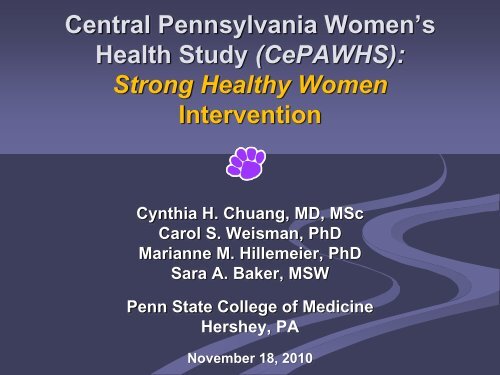

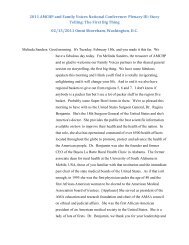



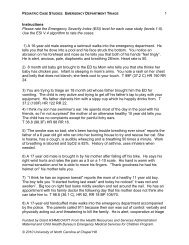
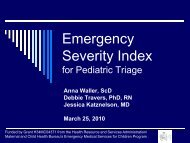
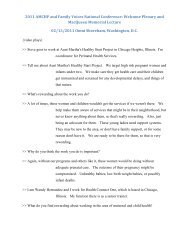
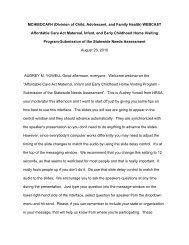
![Hormone Disruptors and Women's Health: Reasons for Concern [PDF]](https://img.yumpu.com/19410002/1/190x245/hormone-disruptors-and-womens-health-reasons-for-concern-pdf.jpg?quality=85)
